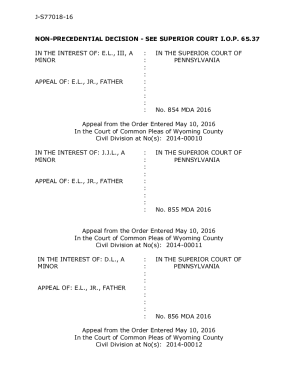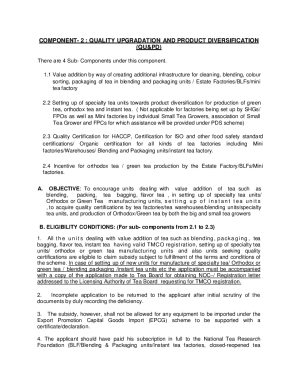
Get the free real estate contract agreement form
Show details
LISTING AGREEMENT THIS AGREEMENT made by and between &, hereinafter collectively referred to as “Owner, and Broker. “ Recitals: 1. Owner is the owner of that certain real property situated in
We are not affiliated with any brand or entity on this form
Get, Create, Make and Sign

Edit your real estate contract agreement form online
Type text, complete fillable fields, insert images, highlight or blackout data for discretion, add comments, and more.

Add your legally-binding signature
Draw or type your signature, upload a signature image, or capture it with your digital camera.

Share your form instantly
Email, fax, or share your real estate contract agreement form via URL. You can also download, print, or export forms to your preferred cloud storage service.
Editing real estate contract agreement online
Use the instructions below to start using our professional PDF editor:
1
Set up an account. If you are a new user, click Start Free Trial and establish a profile.
2
Prepare a file. Use the Add New button. Then upload your file to the system from your device, importing it from internal mail, the cloud, or by adding its URL.
3
Edit real estate forms. Replace text, adding objects, rearranging pages, and more. Then select the Documents tab to combine, divide, lock or unlock the file.
4
Save your file. Select it in the list of your records. Then, move the cursor to the right toolbar and choose one of the available exporting methods: save it in multiple formats, download it as a PDF, send it by email, or store it in the cloud.
With pdfFiller, it's always easy to work with documents. Try it out!
How to fill out real estate contract agreement

How to fill out a real estate contract agreement?
01
Begin by obtaining a standard real estate contract agreement form, which can be obtained from a real estate agent, lawyer, or online legal websites.
02
Carefully read through the entire contract agreement, ensuring you understand each section and term.
03
Fill out the basic information section, including the names and addresses of both the buyer and the seller, as well as the address of the property being sold.
04
Provide a detailed description of the property, including any fixtures or appliances that are included in the sale.
05
Specify the purchase price and the terms of payment, including any down payment or financing arrangements.
06
Include any contingencies or conditions that need to be met for the contract to be binding, such as a satisfactory home inspection or mortgage approval.
07
Outline any additional terms or conditions that both parties have agreed upon, such as the closing date or possession date.
08
Make sure to include any disclosures required by law, such as lead-based paint or other environmental hazards.
09
Both the buyer and the seller should carefully review the entire contract agreement before signing it.
10
It is recommended to have the contract agreement reviewed by a real estate lawyer to ensure all legal aspects are in order.
Who needs a real estate contract agreement?
01
Buyers and Sellers: Anyone involved in a real estate transaction, whether buying or selling a property, needs a real estate contract agreement. It serves as a legally binding document that outlines the terms and conditions of the sale.
02
Real Estate Agents: Real estate agents use contract agreements to formalize the terms of a sale and protect their clients' interests. They can assist in filling out the agreement accurately.
03
Real Estate Lawyers: Buyers or sellers may engage a real estate lawyer to review and advise on the contract agreement to ensure it is fair and legally binding.
Fill exclusive agency real estate : Try Risk Free
For pdfFiller’s FAQs
Below is a list of the most common customer questions. If you can’t find an answer to your question, please don’t hesitate to reach out to us.
What is real estate contract agreement?
A real estate contract agreement, also known as a purchase agreement or a sales contract, is a legally binding document between the buyer and the seller in a real estate transaction. It outlines the terms and conditions of the sale, including the purchase price, the property description, the financing details, and any contingencies or conditions that need to be met for the sale to proceed. The agreement serves as a legal protection for both parties involved and helps ensure that all parties are aware of their rights and obligations throughout the transaction.
Who is required to file real estate contract agreement?
The parties involved in a real estate contract agreement are required to file the agreement. This typically includes the buyer and seller of the property, as well as any real estate agents or brokers involved in the transaction. The agreement is typically filed with the appropriate local government authority, such as the county recorder's office or land registry office, to establish the legal record of the transaction.
How to fill out real estate contract agreement?
Filling out a real estate contract agreement can be a detailed process, but here are the general steps to follow:
1. Start with the basic information: Begin by filling in the date, full legal names, addresses, and contact information of both parties involved in the transaction (buyer and seller).
2. Provide property details: Include the address and legal description of the property being sold.
3. Specify the purchase price: Clearly state the agreed-upon purchase price for the property. You may also need to mention the deposit or earnest money amount, the intended method of payment, and any financing involved.
4. Outline financing terms: If the buyer is obtaining a mortgage or any other form of financing, describe the terms, including the lender's name, loan amount, interest rate, and deadline for securing the financing.
5. Address property condition: Specify the condition of the property upon closing, any appliances or fixtures included in the sale, and any seller representations or buyer inspections.
6. Set the closing date: Agree upon a date by which the transaction should be closed and the property ownership transferred. Include any contingencies or conditions for the closing.
7. Outline contingencies: Common contingencies include mortgage approval, home inspection, appraisal, or the sale of the buyer's current property. Specify the timeframe for satisfying these contingencies and the consequences if they are not met.
8. Discuss property disclosures: Ensure any known defects or issues with the property are disclosed by the seller in accordance with local laws.
9. Include addenda or attachments: If there are additional documents relevant to the transaction, such as the property title, lead-based paint disclosure, or HOA bylaws, include them as attachments or addenda.
10. Review and sign: Carefully read through the agreement to ensure accuracy and understanding. Signatures and dates should be included by both the buyer and seller, as well as any witnesses or notaries required.
It's important to note that real estate contracts can vary by jurisdiction, so it is advisable to consult with a real estate attorney or agent familiar with local laws and regulations to ensure compliance.
What is the purpose of real estate contract agreement?
The purpose of a real estate contract agreement is to establish the terms and conditions of a real estate transaction between a buyer and a seller. It serves as a legally binding document that outlines the rights, obligations, and responsibilities of both parties involved in the sale, purchase, or lease of a property. The contract agreement typically includes important details such as the property description, purchase price, payment terms, closing date, conditions for inspection and repair, contingencies, financing arrangements, and any other relevant terms negotiated between the parties. Its primary objectives are to protect the interests of both parties, provide clarity and enforceability, and ensure a smooth and fair transaction.
What information must be reported on real estate contract agreement?
The information that must be reported on a real estate contract agreement will vary depending on the jurisdiction and specific requirements, but typically it will include the following:
1. Identification of the parties involved: The names and contact information of both the buyer and seller, as well as any agents or representatives involved in the transaction.
2. Property details: A detailed description of the property, including its address, legal description, and any identifying numbers or codes.
3. Financial terms: The agreed-upon purchase price, payment terms (such as down payment, financing arrangements, and contingencies), and any additional costs or fees associated with the transaction (e.g., closing costs, taxes).
4. Contingencies and conditions: Any conditions that must be met before the sale can be completed, such as satisfactory home inspections, obtaining financing, or the sale of another property.
5. Closing date: The date on which the transfer of ownership will occur, as well as any specific timelines or deadlines related to the transaction.
6. Representations and warranties: Any guarantees or assurances made by either party regarding the condition or legal status of the property, including disclosures of known defects or issues.
7. Default and remedies: Terms outlining what will happen if either party fails to fulfill their obligations under the contract, as well as the available remedies in case of a breach.
8. Signatures and acknowledgement: The contract should be signed by all parties involved, indicating their acceptance and agreement to the terms outlined.
It's important to note that these are general guidelines, and specific requirements may differ depending on the local laws and regulations governing real estate transactions.
What is the penalty for the late filing of real estate contract agreement?
The penalty for the late filing of a real estate contract agreement may vary depending on the jurisdiction and specific circumstances. Generally, late filing of such agreements can result in fines, penalties, interest charges, or even potential legal consequences. It is advisable to consult with a lawyer or local real estate authority to determine the specific penalties that may apply in your jurisdiction.
How can I send real estate contract agreement to be eSigned by others?
When your real estate forms is finished, send it to recipients securely and gather eSignatures with pdfFiller. You may email, text, fax, mail, or notarize a PDF straight from your account. Create an account today to test it.
How do I make changes in agent contract?
pdfFiller not only lets you change the content of your files, but you can also change the number and order of pages. Upload your exclusive agent agreement pdf to the editor and make any changes in a few clicks. The editor lets you black out, type, and erase text in PDFs. You can also add images, sticky notes, and text boxes, as well as many other things.
Can I sign the agent agreement electronically in Chrome?
Yes. By adding the solution to your Chrome browser, you may use pdfFiller to eSign documents while also enjoying all of the PDF editor's capabilities in one spot. Create a legally enforceable eSignature by sketching, typing, or uploading a photo of your handwritten signature using the extension. Whatever option you select, you'll be able to eSign your real estate contract form in seconds.
Fill out your real estate contract agreement online with pdfFiller!
pdfFiller is an end-to-end solution for managing, creating, and editing documents and forms in the cloud. Save time and hassle by preparing your tax forms online.

Agent Contract is not the form you're looking for?Search for another form here.
Keywords relevant to real estate contract form
Related to exclusive agency agreement sample
If you believe that this page should be taken down, please follow our DMCA take down process
here
.





















